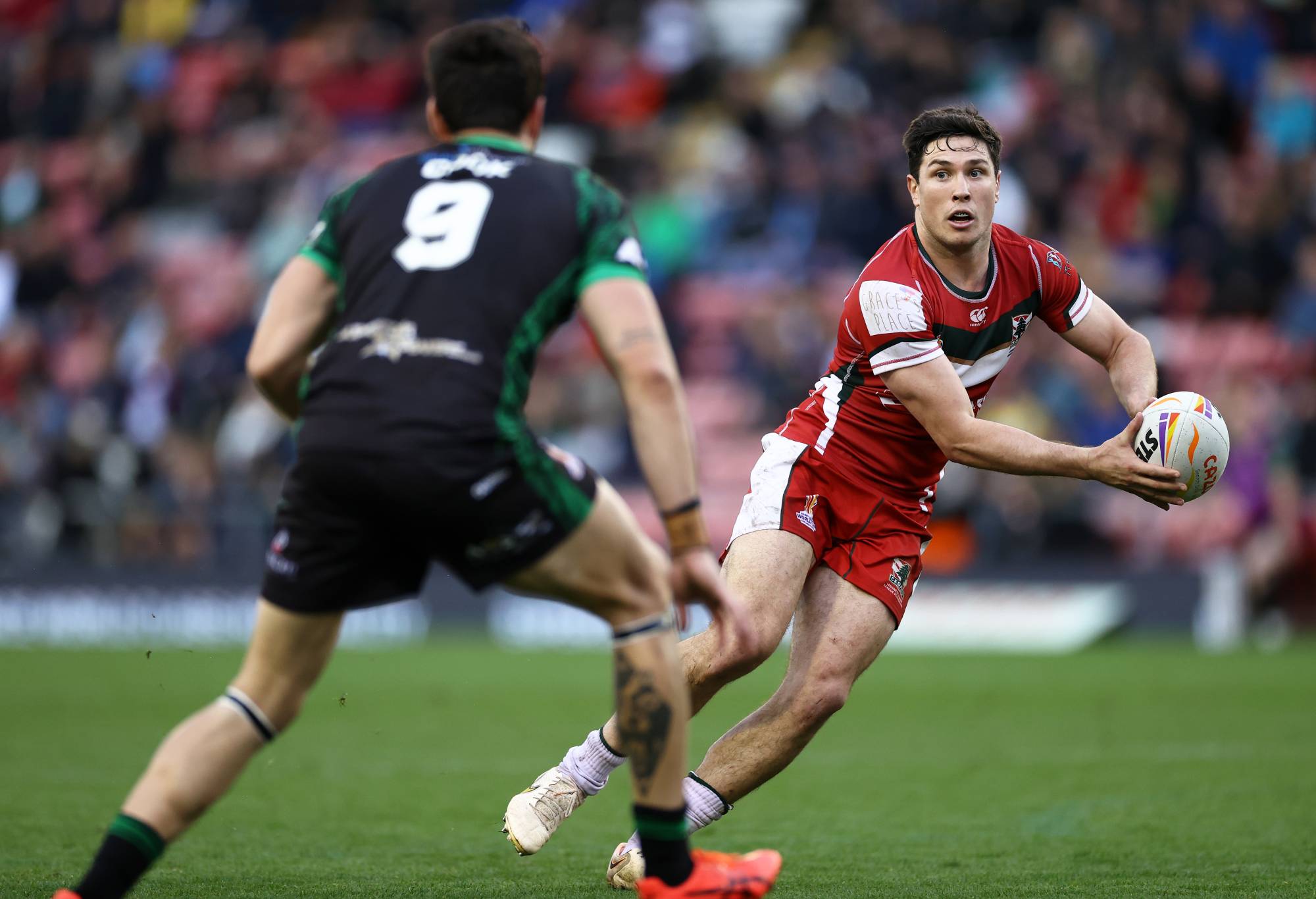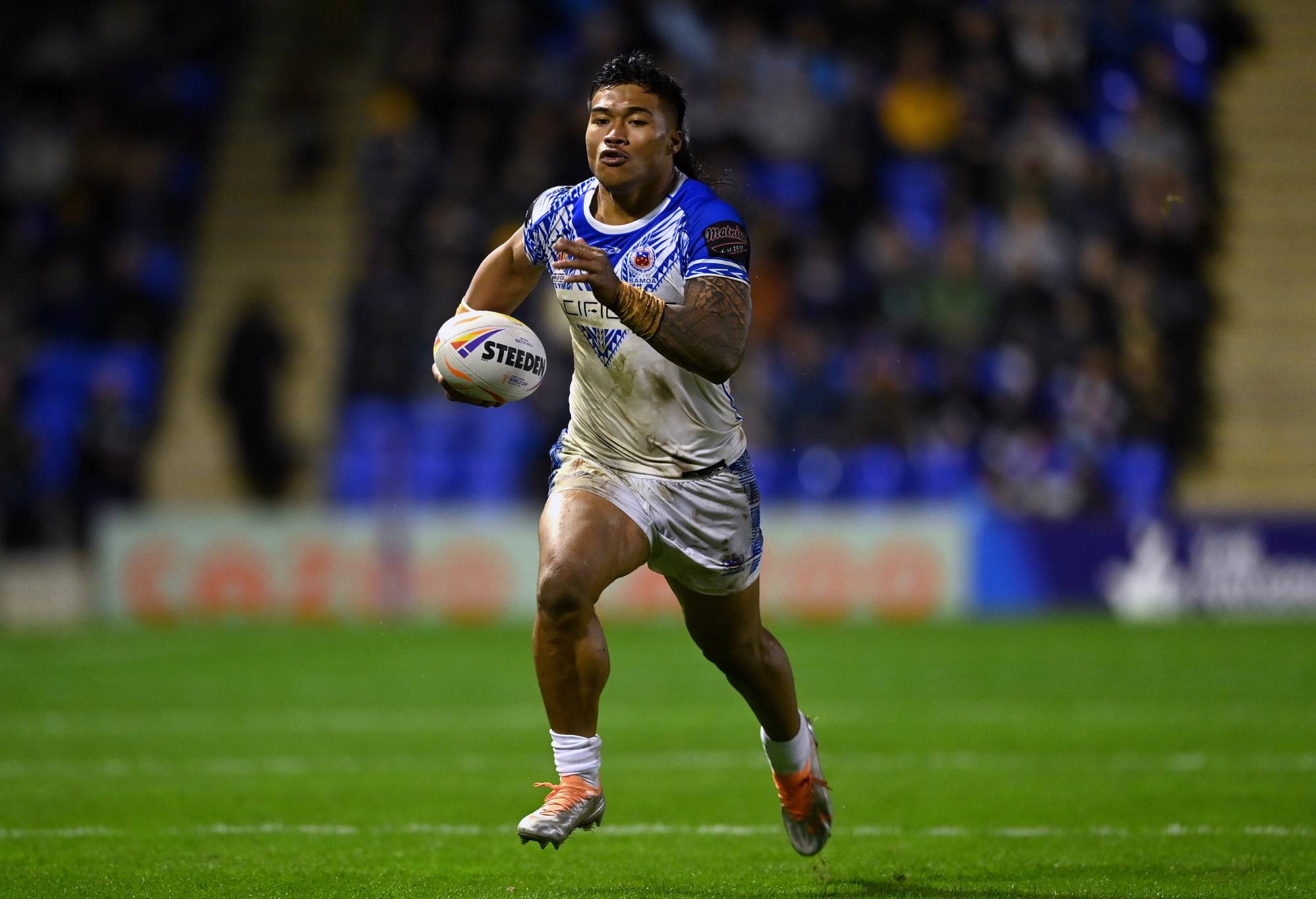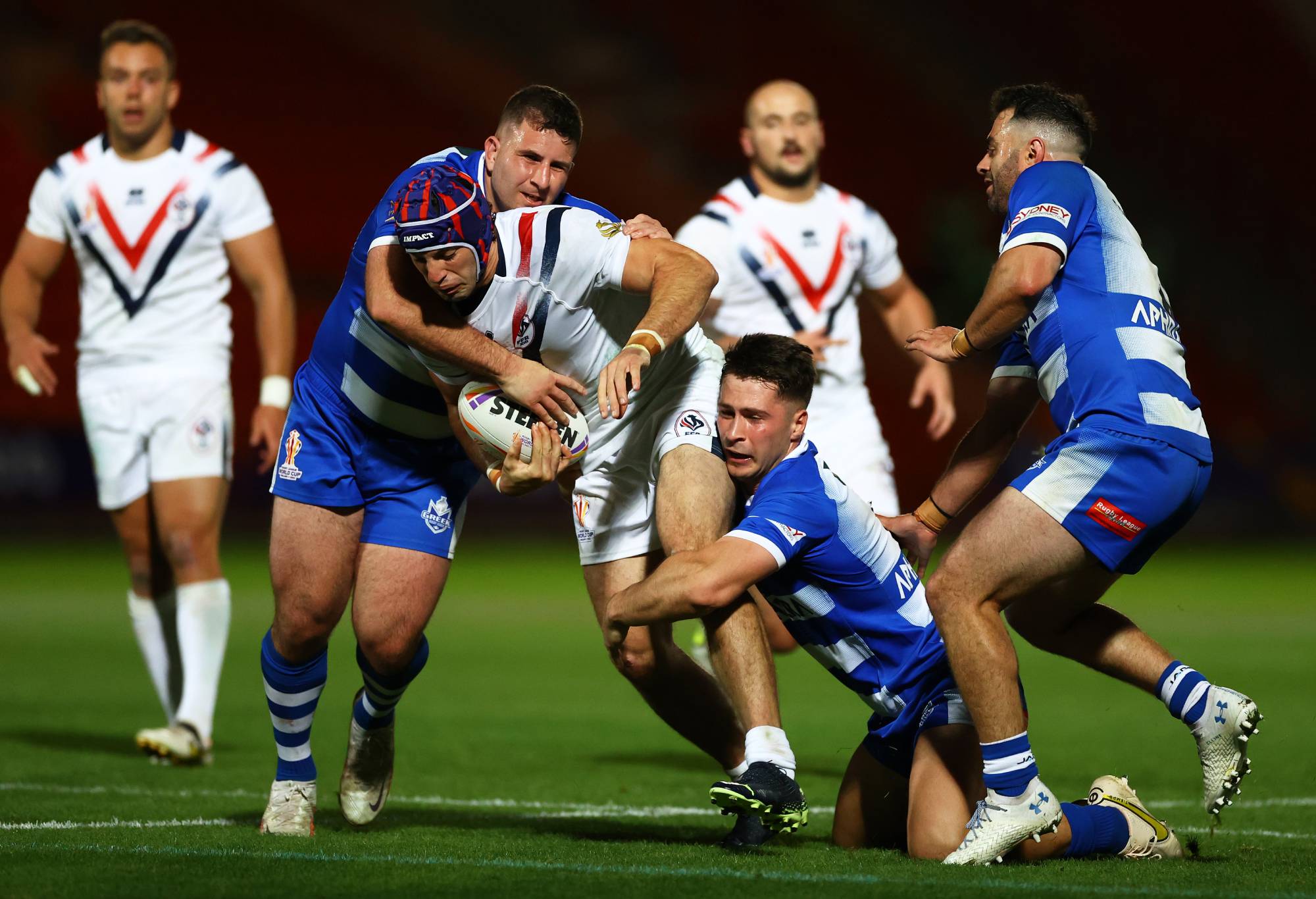Kiwi aggression, Mal's picks and Fonua-Blake's big mouth: Five things to watch in the Pacific Championships
What to look out for in this weekend's round of international footy.
ROCHDALE – Talking about the tactical demands of rep footy can be something of a challenge. An alternative title for this might have been ‘are there tactics in international rugby league?’, because it is a legitimate question if what we understand as rugby league tactics actually exist at this level, or indeed, any rep level.
Our game is one that, at its root, is based on systems. It’s the strongest weak-link sport, and if you don’t believe me, I present to you a lot of recent blowouts. It doesn’t matter if you have superstars if you also have part-timers and amateurs. The other team just runs at the little guy who looks knackered.
Over the course of the group stage, I have spoken to a lot of the coaches across elite sides and non-elite sides, across men’s and women’s, to discern what they’re telling their players.
What I heard was markedly different to what NRL coaches say, for reasons that are easy enough to understand: you have less time – Ivan Cleary has had a fairly settled group for three seasons straight now – and fewer opportunities to actually coach anyone.
One leading coach said it was more about ‘platforms’, where you set up one or two key systems and then let your players make up the rest. There was no need for pet plays or structure, which take months to hone, so don’t bother with it.
Another mentioned ‘philosophy’ around attack and defence, wherein you could set ground rules on controllable, instant things like effort and enthusiasm, but forego cohesion, seen as you can’t build it fast enough.
Plenty suggested that you could coach tactics to a limited extent but that greater effort should go into building an environment.
As a coaching group, you have control over every aspect of their surroundings, from hotels to activities to medical facilities, so it was easier to create bands of brothers (or sisters) from nothing than coherent footy teams with distinct playing styles.

(Photo by Jan Kruger/Getty Images for RLWC)
This is born out in what, to my mind at least, was the main driving factor in tactical analysis at this World Cup. The key dynamic on show has been chaos v control.
To some extent, this is always at play in rugby league, because each team sets itself on a spectrum through various aspects of their play.
This is quite obvious if you watch enough NRL, because you can put a mark on a sliding scale for most teams in terms of what they are trying to do with highly controlled at one end and manic at the other.
St George Illawarra, for example, have a surfeit of control and an absence of chaos. They play very conservatively – I have often described them as the worst team to watch in the NRL – and rely on one or two players to do something special to score. Actually, it’s just Ben Hunt. The coach, Anthony Griffin, only talks about missed tackles and completion rates.
CLICK HERE for a seven-day free trial for your favourite sport on KAYO
The Bulldogs under Mick Potter might have been the opposite. They played with abandon, utilising early kicks, lots of offloads and deep shifts to generate advantageous situations.
This might have been due to it suiting their best players, as Matt Burton, Josh Addo-Carr and Tevita Pangai jnr are going to do that sort of thing anyway, but also because the culture demanded it in the post-Trent Barrett era. Players were sick of over-structure, so let them go out and just play.
Clubs get years to practice and build systems, so it’s not surprising that they are better-formed thoughts, as it were, than rep teams. If you only get a week before the tournament to build, obviously things are going to be less defined.
Even within that, however, the talent disparities are a major factor. France were a good example of this: against Greece, where they had the better cattle, they played highly within themselves, knowing that they could grind a win against part-timers.
Against England, they were far more expansive, playing with the knowledge that would lose if they got in a grind with a better playing group, but might have a chance if they had a crack.
They tried the same against Samoa, but met a highly-controlled performance by better players, as well as copping a few injuries and bad luck. Such is chaos footy.

(Photo by Gareth Copley/Getty Images)
If we accept that each team is limited by their players – unlike in the NRL, where theoretically all teams have access to the same resources – then you tactical approach will stem from where your better players are.
The World Cup has thrown up some great examples. Greece and Lebanon are unequally talented from 1-17, but all their best players are halves, so they’ve played a much more expansive style that befits who they can put onto the field.
If your props are Greek domestic players, but your halfback and hooker play for South Sydney, then your best chance is to chuck the ball. Similarly, Lebanon’s best players are their 1, 6 and 7, so dying wondering is not going to get them anywhere.
On the other hand, Tonga have an all-star forward pack and an 18-year-old halfback who, while highly touted, was playing the Penrith comp as recently as this season. It’s obvious for them that bash it up the middle is probably going to work best.
PNG have limited NRL experience but strong halves cohesion and pre-existing combinations, plus a fair wind of variance that nearly took them to the upset, before roster strength kicked in and Tonga were able to produce a miracle play to win.
Ireland v Lebanon, on paper one of the closest games of the groups, was a classic of the style-make-fights genre.
Ged Corcoran had a team with a lot of good, hard forwards, two massive wingers and a scheming half in Luke Keary who he could trust to make the right decisions to score them points. They went for a power game to bash the front door in.
Michael Cheika had excellent playmakers, but relatively limited back-row and edge options, so his side attempted to change the point of attack, move the opposition’s big lads around and win rucks low to the ground.
As a result, they won double the amount of penalties in the first half, stole the ball five times and generated far more possession, which they were able to bank as points through their skilled playmakers. On that day, chaos reigned.

BOLTON, ENGLAND – FEBRUARY 03: Shaun Wane speaks to the media as he is appointed Head Coach of the England men’s Rugby League team at University of Bolton Stadium on February 03, 2020 in Bolton, England. (Photo by Nathan Stirk/Getty Images)
We’re yet to see the big teams reveal their hands in this regard, though it’s fairly obvious how some will go.
Australia are the most interesting test case, because they have never picked their strongest side and, at any rate, might not need to. Roster strength can trump all.
Mal Meninga hasn’t coached club footy since 2001 and, indeed, has coached just over 50 games total in the intervening 21 years. It’s not a sample size from which we can discern what sort of coach he is.
For what it’s worth, having the best players and telling them to go out and play like it isn’t that bad a plan if your players are prime Queensland with several future Immortals, or indeed, the Australia Kangaroos.
Conversely, England have Shaun Wane, a highly ideological coach. He believes in defence-first football with strong kicking: his Wigan sides did that for years and, in truth, his roster dictates that England should too. He’s the right coach for this group.
The key tenets of his style require your forwards to be your best players – tick – and your halves to be ‘moments’ guys, which he has in George Williams, still arguably the best short-kicker in the game, and Jack Welsby, as close to an instinctual wildcard as exists in the analytics-heavy world of modern rugby league.
New Zealand, too, could well approach this way. They’re forced to by their pack, which is the strongest at the tournament, and their halves. Like England, their outside backs are their weakest area, so batter in the front door.
We’ve seen enough of Michael Maguire in the NRL to suggest that this suits him. He won a Premiership with Souths based on it: remember, his Grand Final centres were Kirisome Auva’a and Dylan Walker with an old Lote Tuqiri and a very young Alex Johnston.
The Pacific nations present different questions. As mentioned, Mate Ma’a Tonga are forced to play a power game by their superlative forwards, though they lack the halves guile that might get them over the line against elite opposition. Even PNG, who are nowhere near as good as the big three, caused them a lot of trouble.
Kristian Woolf has beaten all of the big 3 without a recognised halfback, so it’s not a prerequisite, but it’s hard to see them beating Samoa, then England, then one of New Zealand or Australia without one.
Fiji’s original coach got ill on the brink of the tournament and his replacement, Wise Kativerata, was a late call-up. His roster dictates much the same as Tonga, but in truth, we have no idea what he wants to do and it’s not really anyone’s fault.
Samoa were underdone against England, but I think they would have lost anyway for much the same reasons.
Though Matt Parish has the same combination of size and skills – though his are more back-based than forward-based – the Samoans are yet to demonstrate a coherent plan that goes further than being better than the opposition, which is something that will probably fail when the opponents get better.

(Photo by Michael Steele/Getty Images)
That last point speaks to another major difference in international footy: benchmarking. There are 16 teams at the World Cup and 16 in the NRL, but the goals are totally different.
There’s no parity of resources, as there is with a salary cap, so you don’t get coaches pretending like they’re trying to win every game. More than one coach has admitted, ahead of time, that they play to win but know they can’t.
That’s where benchmarking comes in. The World Cup is a twice-per-decade temperature test on the strength of the game in different places. France, for example, were devastated to go out in the manner that they did, but their clear focus is 2025. Other sides were happy just to get there at all.
Ireland lost to Lebanon and therefore missed the quarters, but whoever finished second in that group was only going to run into the Kangaroos anyway. Again, they might argue that picking a younger squad this time with one eye on 2025 and ongoing international commitments is more important.
There’s essentially two World Cups – the one that just ended, where six treat it like a training run, six make up the numbers and are happy to win a single game and a maximum of four – France, Lebanon, Ireland and PNG – are somewhere in between. When that ends, you get the knockouts, something else entirely.
If Australia go home without the trophy, it’s a catastrophic failure, but for everyone else…less so.
If England make the final and don’t fall flat on their face, they can probably hold their heads up high. Ditto Tonga, who have never made it that far before.
Samoa should be in the same boat as Tonga, but haven’t actually got that far before and going out having been trounced by England and defeated by their biggest rivals, with their strongest ever squad, will be seen as a failure.
The Kiwis will think they can win, but in their heart of hearts, know that the Kangaroos have a better 1-17 and they will have to pull off an upset. Lose closely in the semi and they’er not happy, but they’re not embarrassed either.
Expectations play back into tactics because they feed into the story going forward. Jamaica will regret that the didn’t have more of a crack in game one against Ireland, as they didn’t score and didn’t look like scoring. If we can’t win, then why not have fun?
Samoa know that their players have to be well-coached, because all their players can play for Australia or New Zealand too. If they leave this tournament thinking they were let down by the structure, next time around, Joseph Suaalii or Brian To’o might decide the Kangaroos is a better option for them.
International footy is about culture, pride and heritage as much as it is about winning – unless you’re Australia, England or New Zealand.
It’s also about fun, because guys turn down cash and risk injury – not to mention prolonging their season away from family – to perform an essentially altruistic act out of love of their people and the sport. Coaches need to reflect that.
It’s something that can actually be a strength. International soccer, for example, is usually worse to watch because the high pressure need for victory incentivises negative play, a function of soccer being a sport in which it is much more difficult to attack than defend.
League can be the opposite: if, of course, you have the right amount of chaos.